how to find average in google sheets
There is no MEAN function in Google Sheets. Just to detect the hateful there are different functions. Y'all may already know the proper noun of the function that you lot can use to notice the Hateful. Information technology's Google Sheets Boilerplate function.
Mean is actually the boilerplate that you lot are familiar with from your school days. The average is the sum divided by count.
There are unlike kinds/types of average calculations (like harmonic hateful and geometric hateful) and specific functions in Google Medico Sheets. Hither we can acquire the normal mean (average) adding.
Since the function proper noun is Boilerplate, here later I'm using the term average instead of Mean.
How to Use Google Sheets Average Function
Syntax: Below is the Syntax of Google Sheets Boilerplate office.
Average(value1, [value2, ...])
Example:
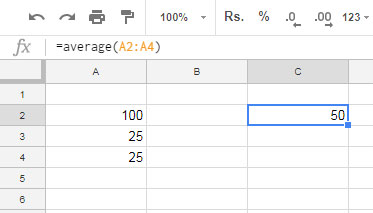
See the use of Google Sheets Boilerplate function. In this example, there are three values and the sum of these values are 150. And then the average of these numbers is 150/three = 50.
I've keyed in the Average formula in Cell C2. Similarly, you lot tin use the Average office in Google Sheets to observe the average.
Skip the Zeros in Average
Run across how 0 affects the average calculation. In the to a higher place instance, if the value in cell A2 is 0, the average calculation will exist like fifty/3=16.67.
To skip null in the Average office in Google Sheets, you lot can use the AVERAGEIF role every bit below.
=averageif(A2:A4,"<>0")
I know you want more details virtually the usage of Averageif. Please refer my Averageif tutorial for more details. AVERAGEIFS is some other function that you tin can use in conditional Average.
Now I'm taking you lot to some advanced level use of the Average function in Google Sheets. Maybe it's piece of cake for some of you lot.
Do yous know how to calculate the average of just the visible values in Google Doc Spread Sheets? Merely read on.
You lot May also like:
1. How to Use Median Role in Google Sheets
two. How to Use Mode Function in Google Sheets
How to Skip / Avert Hidden Row Values in Average Adding
There is an alternative to Google Sheets Average part.
Yep! y'all accept heard me right. No matter your data is filtered or not you tin use an culling function to observe the Boilerplate in Google Sheets.
Sometimes we hibernate sure rows. Similarly, a filtered data table may also contain hidden rows. And so what is the formula to detect the Average of only visible rows in Google Sheets?
Subtotal(101,
Yes! yous tin use the subtotal part to discover the average in Google Sheets. The Subtotal part uses different function numbers to observe Average, Count, Counta, Max, Min, Production, Stdev, Stdevp, Sum, Var, and Varp.
Just follow the following link to larn how to use the powerful Subtotal role in Google Sheets and understand the so-called function numbers.
Must Read: What is Part Numbers in Google Sheets
Just use the Subtotal office with part number 101 to find the average. Unlike the higher up Google Sheets Average function, this alternative simply finds the average of visible cells.
Example:
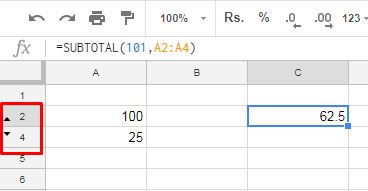
In the above example, I've used the Subtotal function in jail cell C2 to find the average. You can see that the row # iii is hidden.
Actually, the value in cell A3 which is hidden is 25. Simply the above Subtotal formula skips this value in the average adding. It adds 100+25 and divide it by 2, i.eastward. 125/two = 62.5.
How to Differentiate Subconscious Rows and Filtered Out Rows in Calculating Average?
There are 2 function numbers that you can apply in Subtotal to find the Average. The first ane is the number 101, which I've already introduced you above.
The above 101 is the best one as it purely considers the visible rows in boilerplate calculations. But you can besides apply the function number 1.
Subtotal(1,
What is the difference between office number 101 and 1 in calculating boilerplate?
Office number 101 excludes both hidden rows and the rows that are not visible due to the filter settings.
On the other hand, part number 1 only excludes the rows that are non visible due to filtering.
In other words, it includes hidden rows. Here subconscious rows mean the rows that you lot made hidden by clicking on the row number to select and right click to hide.
Grouping and Average in Google Sheets
There is one unique way of finding group wise average in Google Sheets. For that, we tin can utilise the Query function and the aggregate role Avg in it.
I'll come up to that. Earlier that allow me explain how to calculate grouping wise boilerplate using Google Sheets Average function.
Here is one instance. In this, I'm trying to discover moth wise boilerplate of Sales Value. It's only an example and the information may not be realistic.
How to Calculate Month Wise Average in Google Sheets?
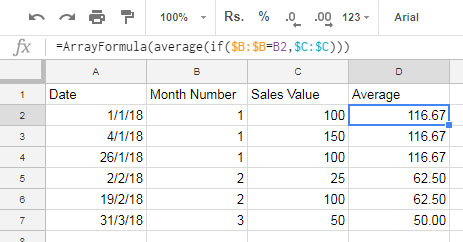
In this example my bodily data was in the columns A and C. I've inserted a new column B to notice the month number using the beneath ArrayFormula in B2 that makes utilize of the Month function.
=ArrayFormula(month(A2:A7))
This formula generates the month number in all the rows in the range B2: B7. Now I can detect the group-wise average in Column D. Hither is the formula that I've used.
=ArrayFormula(average(if($B:$B=B2,$C:$C)))
Fifty-fifty though I've used the ArrayFormula function in information technology, information technology won't expand. Yous should copy and paste this formula in all the required rows in column D, I mean in the range D2: D7.
Tin can I use the Subtotal part to find group wise Average in Google Sheets?
You tin't use the Subtotal function replacing the Boilerplate in the above formula as the former only accepts cell references as arguments. In the above formula, I've used an IF logical test as an argument.
Earlier I've mentioned the use of Query in group-wise average. Here is the case.
Calendar month Wise Boilerplate Using Google Sheets Query
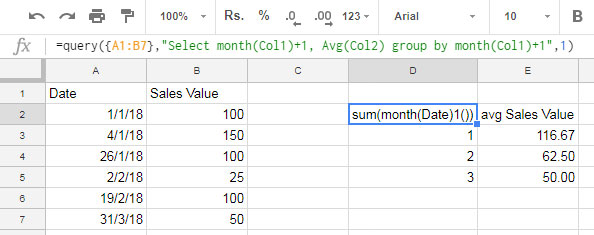
Since I've already explained (in another tutorial) how to utilise the Query function in Google Doc Spreadsheet, I am skipping this formula explanation here.
If yous know how to utilize Query, and then y'all tin can easily use it to notice Group wise average. Otherwise please just adjust your information equally per my higher up sample data range and use the formula as it's.
Google Sheets Query: How to Convert Calendar month in Number to Calendar month Proper name in Text
Group Wise Boilerplate in Filtered Data Set in Google Sheets
In grouping also we can merely include the visible rows in the Boilerplate adding. The beneath example explains how to calculate the average of visible rows in Group.
Here we require a helper column as below.
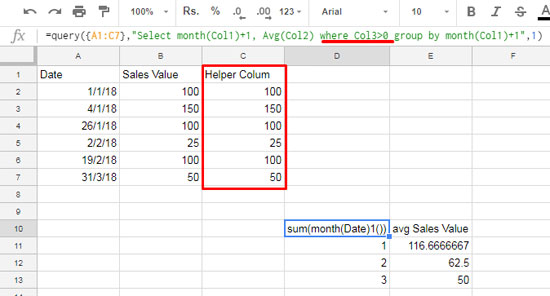
Here I've used the same formula which I used in the just to a higher place example (under the title "Calendar month Wise Boilerplate Using Google Sheets Query").
But here I've fabricated some minor changes to the formula and the data used. I've marked both changes in the above screenshot. What are they?
Cavalcade C, which is a helper column, is new here. In this helper column, in cell C2 utilise the below formula so copy and paste it to all the rows down (range C2: C7)
=subtotal(109,B2)
Why this formula?
The above Subtotal formula can render the value 0 if the row is hidden or not visible. For case, I am hiding the row # 5. At present the cell value in C5 becomes 0. This's 1 of the powerful features of the Subtotal role.
In the Query, with an additional "where" clause, we tin exclude hidden rows in the Boilerplate adding. Please refer the above screenshot to run across the changes in the formula which is underlined.
That'southward all most Google Sheets Average office and some advanced tips related to average adding in Google Sheets. Savor!
Source: https://infoinspired.com/google-docs/spreadsheet/google-sheets-average-function/
Posted by: alleneaunded1981.blogspot.com

0 Response to "how to find average in google sheets"
Post a Comment